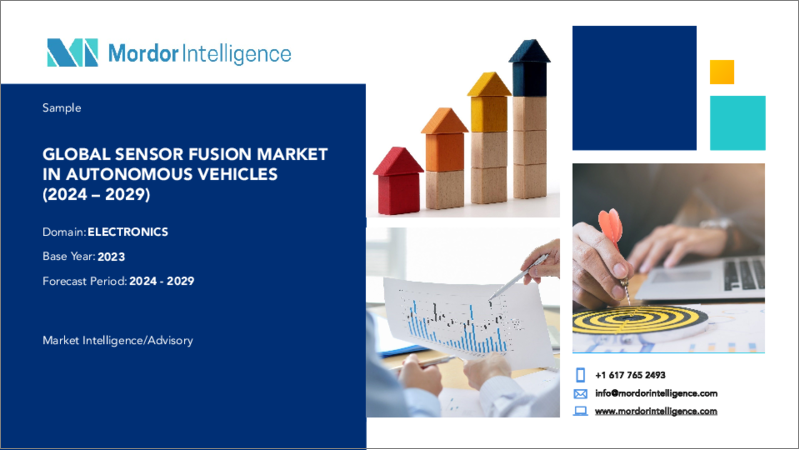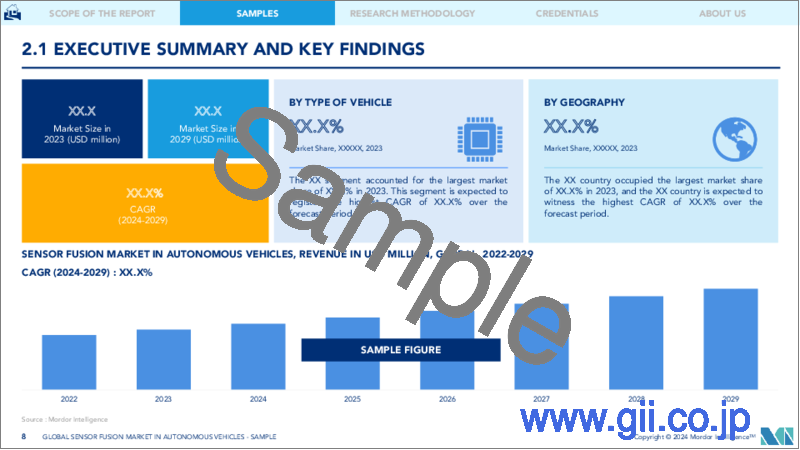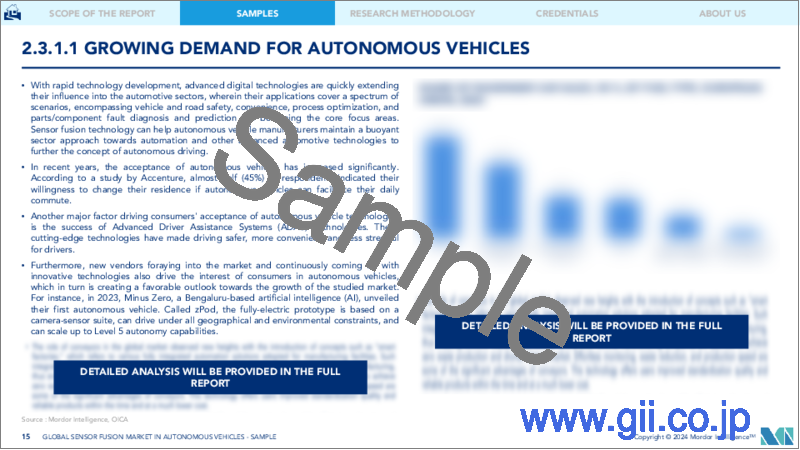|
|
市場調査レポート
商品コード
1237846
自律走行車におけるセンサーフュージョン市場- 成長、動向、および予測(2023年-2028年)Sensor Fusion Market In Autonomous Vehicles - Growth, Trends, And Forecasts (2023 - 2028) |
||||||
|
● お客様のご希望に応じて、既存データの加工や未掲載情報(例:国別セグメント)の追加などの対応が可能です。 詳細はお問い合わせください。 |
|||||||
| 自律走行車におけるセンサーフュージョン市場- 成長、動向、および予測(2023年-2028年) |
|
出版日: 2023年03月03日
発行: Mordor Intelligence
ページ情報: 英文 120 Pages
納期: 2~3営業日
|
- 全表示
- 概要
- 目次
自律走行車におけるセンサーフュージョン市場は、予測期間中にCAGR19.6%を記録して成長すると予想されています。
先進運転支援システム(ADAS)、新しいレーダーシステム、カメラ、ライダー、GNSSセンサーなど、自律走行車に高度な機能性を盛り込む傾向が強まり、変数を迅速かつ安全に検知して対応する柔軟なシステムの要件が強化されたことも、自律走行車におけるセンサーフュージョンの成長を促す大きな要因の1つになっています。
主なハイライト
- センサー間の矛盾の解決、センサーの同期、物体の将来の位置の予測、自動運転の安全要件の達成は、自律走行車のアプリケーションにおけるセンサーフュージョンの主要な目的の一部です。世界経済フォーラムによると、2035年までに年間1200万台以上の完全自律走行車が販売されると予想されています。自律走行車は、世界の自動車市場の25%を占めるようになると言われています。インテルによると、1台の自律走行車は1日に平均4テラバイトのデータを生成することができます。センスフュージョンソリューションは、この膨大なデータをリアルタイムで活用する上で重要な役割を果たすことができます。
- ADASの開発が進み、GPS-IMU(慣性計測ユニット)フュージョンの原理が利用されるようになると、絶対位置の測定間隔における推測誤差の累積を解消することができます。テスラの自動運転機能「オートパイロット」は、前方カメラやセンサーから収集したデータから正確な位置を割り出し、高速道路の車線で車両の中心を維持するなどの機能を実現するADASの一例です。
- 自動車メーカーとソフトウェア企業のコラボレーションは、市場において一般的な動向です。例えば、2021年4月、ライダーセンサーを提供するRoboSenseは、インテリジェント自動車用オペレーティングシステムとソリューションを提供するBanma Network Technology、および中国の大手ロボットタクシー事業者のAutoXと、インテリジェント自動車用のハイレベルな自律走行プラットフォームを構築するためのパートナーシップを締結しました。このパートナーシップは、AI機能、ハードウェア、ソフトウェアの融合により、インテリジェントコックピットと自律走行システムの統合を促進することを主な目的として設立されました。
- 世界的に厳しい政府規制も、調査対象市場の製品需要を後押ししています。例えば、Euro NCAP(欧州新車評価プログラム)では、少なくとも1つの運転支援システムの導入が義務付けられています。日本や米国のような国も、国内のNCAP規則で同様の基準を採用しています。
- 自律走行技術の安全性問題の高まりは、自律走行車の採用を制限するだけでなく、センサーフュージョンソリューションの信憑性を主張する可能性があります。標準化は、センサーフュージョンシステムの進化を妨げる要因の一つです。世界スタンダードがなければ、デバイスやICの複雑さは指数関数的に増加すると予想されます。
- COVID-19の発生は、世界的に自動車分野への影響を強めています。屋外での活動が減少したため、主にパンデミックの初期段階において、自動車の需要は大幅に減少しました。さらに、自動車部品の供給の減少や生産設備の停止により、自動車メーカーの運転資金が減少し、新技術への投資の遅延や減少を招きました。しかし、自動車産業がパンデミックから回復したことで、センサーフュージョンソリューションプロバイダーには新たな機会が到来しています。
自律走行車におけるセンサーフュージョン市場動向
乗用車が大きな市場シェアを占める
- 乗用車メーカーの間では、プレミアムな機能を備えた車への需要の高まりから、自律走行車の開発への関心が高まっています。自動車メーカー、テクノロジー企業、研究者は、自律走行車の背後にある技術のさらなる開発に継続的に取り組んでいます。これらの自動車には大量のデータを収集する複数のセンサーが搭載されているため、センサーフュージョンは、ベンダーがセンサーデータを賢く利用できるようにする理想的なソリューションとして登場しました。
- 近年、乗用車の販売台数は増加傾向にあります。パンデミックは成長に影響を与えたが、その影響は短期的なものであり、今後数年間は牽引役となることが予想されます。例えば、OICAによると、2021年の乗用車の販売台数は、2020年の5390万台から5640万台に増加します。このような動向は、調査対象市場の成長の重要な促進要因として機能すると予想されます。
- 自律走行車の重要な側面の1つは経路計画です。センサーフュージョンは、センサーの読み取り値を統合して車両の状態を正確に把握し、周囲の物体の軌道を予測することで、重要な役割を担っています。したがって、今後、自律走行する乗用車の販売台数の増加に伴い、採用が増加すると考えられます。
- さらに、自動緊急ブレーキ(AEB)は、促進要因が他の車両や交通弱者との衝突を回避または軽減することを支援する強化されたアクティブセーフティシステムです。誤検知を最小限に抑えつつ、正確で信頼性の高い強固な検知を行うためには、多くの場合、複数のセンサーが必要となります。自動車産業、特に乗用車セグメントにおいて安全性がますます重要な課題となっている中、AEBシステムの採用が増加しており、センサーフュージョンシステムの需要にプラスの影響を与えると予想されます。
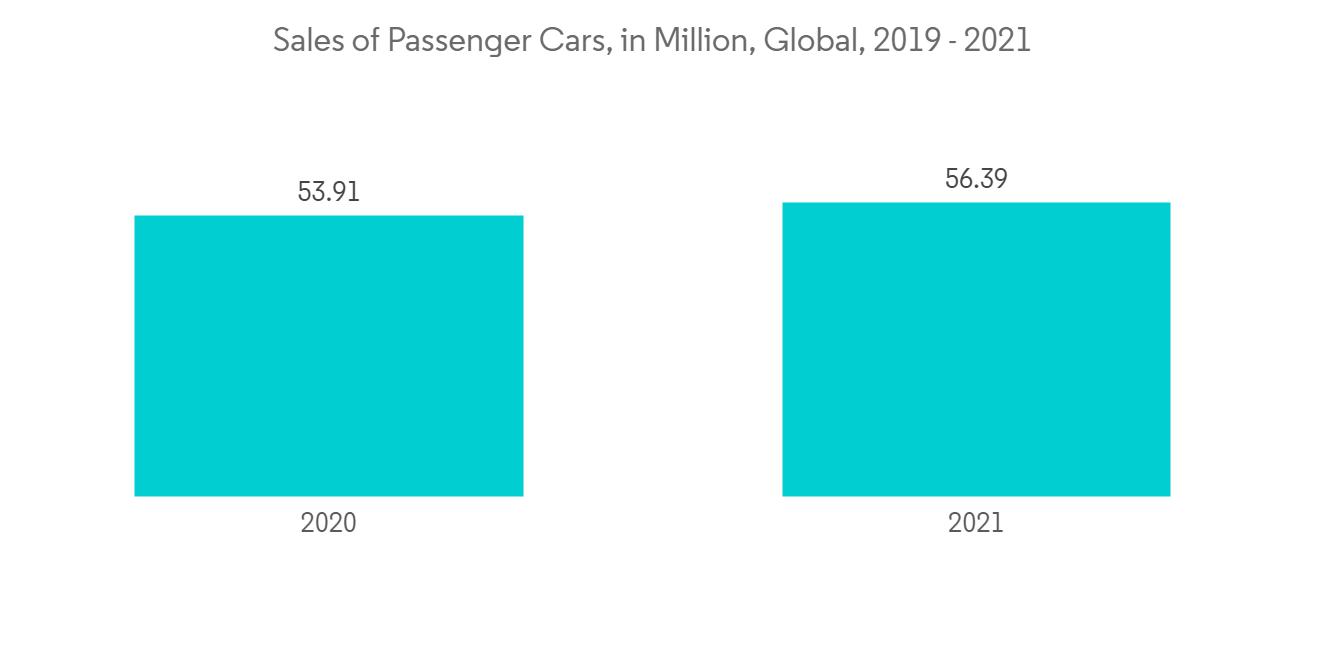
北米が大きな市場シェアを占める
- 北米は、世界でも有数の自動車生産拠点です。この地域の経済成長は、乗用車や商用車の販売に影響を及ぼしています。米国は北米地域の主要な自動車メーカーのひとつであり、国内消費が多いだけでなく、世界的に自動車を輸出しています。例えば、米国国際貿易委員会によると、2021年の軽自動車の輸出台数は161万9,350千台に達しています。
- また、この地域は、ADAS対応車や自動運転交通ソリューションの採用におけるパイオニアの1つです。ドイツ銀行によると、米国のADASユニット生産台数は2021年に1845万台に達すると予測されています。ADAS(先進運転支援システム)は、アダプティブクルーズコントロール(ACC)、自動緊急ブレーキ(AEB)、車線逸脱、ブラインドスポット検出、360ツーサラウンドビューなどに対応可能で、ADASシステムの設計には多くのセンサーが使用されているため、こうした動向が同国におけるセンサーフュージョンソリューションの需要を促進すると予想されます。
- ITAによると、カナダは北米地域で2番目に大きな自動車市場であり、新車市場の約4分の3を輸入車が占めています。2021年、乗用車の輸入額は約26%(前年比)増の278億米ドルとなりました。同国では自律走行車に対する受容が著しく進んでおり、自動車メーカーに投資の拡大を促しています。例えば、Tesla、Uber、トヨタ、BMW、GM、日産などの技術・モーター企業が、カナダの消費者向けに自律走行車の開発競争を繰り広げています。
- さらに、Robotaxis(複数のLiDARを含む高度なセンシング技術の強力な配列に依存し、複雑な都市環境を安全に操縦する)は、まだここまで来ていないです。それでも、Waymo、Cruise、Uberは米国で多額の投資を行い、実験車両を運用しており、将来の機会を生み出すと予想されます。
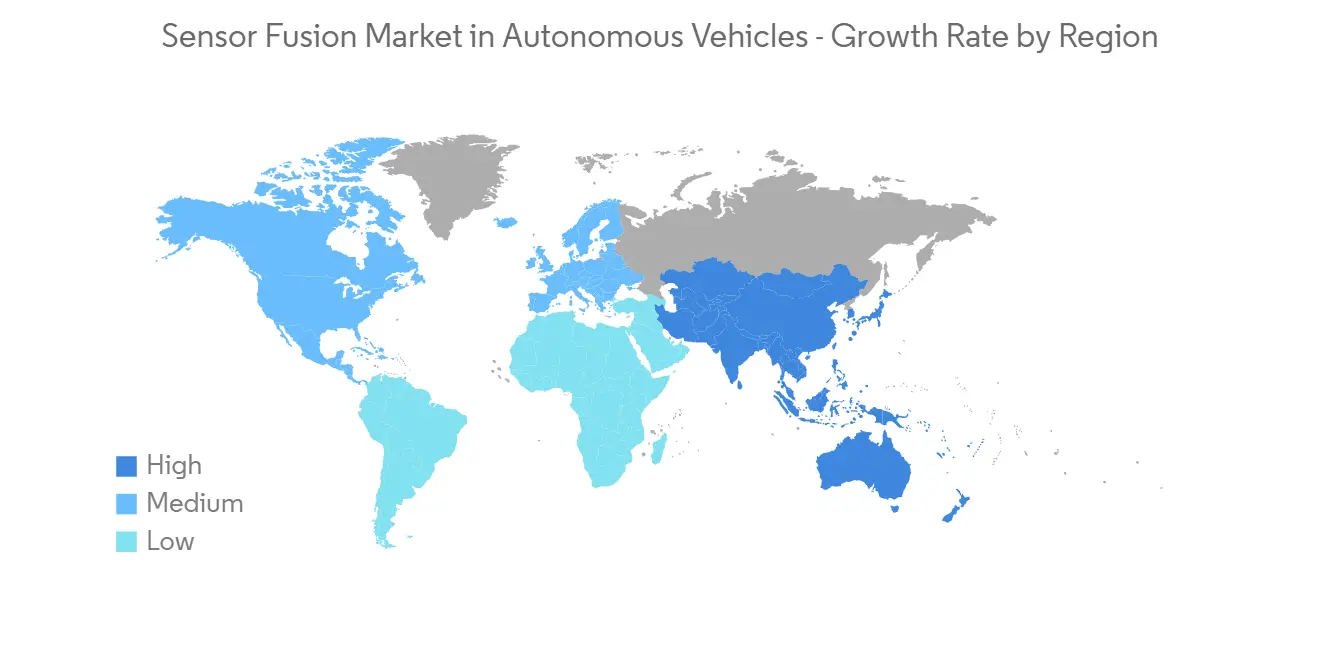
自律走行車におけるセンサーフュージョン市場の競合他社分析
自律走行車におけるセンサーフュージョン市場は、ボッシュ、STマイクロエレクトロニクス、NXPセミコンダクターズNVなどの大企業と、この技術に特化した新規参入企業が混在しているため、競争は緩やかです。ベンダーは、将来の自律走行車向けにこの技術を準備し、手頃な価格にするための開発にますます力を注いでいます。
2022年10月- 米国の大手自動車センサーソリューションプロバイダーであるマイクロビジョンは、ブリュッセルで開催されたAutoSens 2022 Showでダイナミックビューライダーシステム「MAVIN DR」を発表しました。MAVIN DRライダーシステムは、ダイナミックな視野を特徴としています。低遅延で高解像度を実現し、新しいADAS安全機能の設計者が、OEMが求める適切なハイウェイパイロット機能を実現することができます。
2022年4月- フォルクスワーゲングループのソフトウェア会社であるCARIADは、センサーデータフュージョンを手がけるIntenta GmbHの自動車部門を買収しました。この買収は、ソフトウェアおよびハードウェア開発における垂直的な価値創造を大規模に拡大し、重要なソフトウェアコンポーネントの自社開発を可能にし、主要な開発分野における付加価値の深化を図るという同社の戦略に沿ったものです。
その他の特典。
- エクセル形式の市場予測(ME)シート
- 3ヶ月のアナリストサポート
目次
第1章 イントロダクション
- 調査の前提条件と市場の定義
- 調査対象範囲
第2章 調査手法
第3章 エグゼクティブサマリー
第4章 マーケットインサイト
- 市場概要
- 産業の魅力- ポーターのファイブフォース分析
- 供給企業の交渉力
- 買い手の交渉力
- 新規参入業者の脅威
- 競争企業間の敵対関係の強さ
- 代替品の脅威
- 産業バリューチェーン分析
- 技術スナップショット
- COVID-19の市場への影響について
第5章 市場力学
- 市場促進要因
- 自律走行車への需要の高まり
- 効率的なリアルタイムデータ処理とデータ共有機能が需要を牽引する
- 市場抑制要因
- センサーフュージョン技術における標準化の欠如
第6章 主な市場動向
- 主な特許と調査活動
- 主な用途と新たな用途
- アダプティブクルーズコントロール(ACC)
- 自動緊急ブレーキ(AEB)
- エレクトロニック・スタビリティ・コントロール(ESC)
- 前方衝突警報(FCW)
- その他の用途
第7章 市場セグメンテーション
- 車種別
- 乗用車
- 小型商用車(LCV)
- 大型商用車(HCV)
- その他の自律走行車
- 地域別に見る
- 北米
- 欧州
- アジア太平洋地域
- ラテンアメリカ
- 中東・アフリカ地域
第8章 競合情勢
- 企業プロファイル
- Robert Bosch GmbH
- Microchip Technology Inc.
- Infineon Technologies AG
- BASELABS GmbH
- NXP Semiconductor
- STMicroelectronics NV
- Aimotive kft
- Kionix Inc(Rohm Co. Ltd)
- TDK Corporation
- CEVA Inc.
第9章 投資分析
第10章 市場の将来展望
The sensor fusion market in autonomous vehicles is expected to grow by registering a CAGR of 19.6% during the forecast period. The growing trend of including advanced functionalities in autonomous vehicles, such as advanced driver assistance systems (ADAS), new radar systems, cameras, lidar, and GNSS sensors enhanced the requirements of flexible systems to quickly and safely detect the variables and respond, which is also among the significant factors driving the growth of sensor fusion in the autonomous vehicle sector.
Key Highlights
- Resolving contradictions between sensors, synchronizing sensors, predicting the future positions of objects, and achieving automated driving safety requirements are some of the primary objectives of sensor fusion in an autonomous vehicle application. According to the World Economic Forum, more than 12 million fully autonomous cars are expected to be sold annually by 2035. Autonomous vehicles will account for 25% of the global automotive market. According to Intel, a single autonomous vehicle can generate an average of 4 terabytes of data per day. Sens fusion solutions can play a significant role in utilizing this massive data in real time.
- The growing development in ADAS and increasing utilization of the principle of GPS-IMU (Inertial Measurement Unit) fusion helps solve accumulated errors of dead reckoning in intervals with absolute position readings. Tesla's Autopilot automated driving feature is an example of an ADAS that can perform functions such as keeping the vehicle center in a highway lane by determining its precise position from data collected from a forward-facing camera and sensors.
- Collaboration between automotive and software companies is a common trend in the market. For instance, in April 2021, RoboSense, a lidar sensor provider, formed a partnership with Banma Network Technology, an intelligent automobile operating system and solution provider, and AutoX, China's leading robotaxi operator, to build a high-level autonomous driving platform for intelligent vehicles. The partnership was established primarily to promote the integration of intelligent cockpits with autonomous driving systems through the fusion of AI Capabilities, hardware, and software.
- Stringent government regulations globally also fuel the demand for the products in the market studied. For instance, Euro NCAP (European New Car Assessment Program) mandates the deployment of at least one driver assistance system. Countries like Japan and the United States also adopt similar criteria in their national NCAP rules.
- The growing safety issue of autonomous technology can not only limit the adoption of autonomous vehicles but could claim the authenticity of sensor fusion solutions. Standardization is one of the factors hindering the evolution of sensor fusion systems. Without global standards, the level of complexity of devices and ICs is expected to increase exponentially.
- The COVID-19 outbreak increasingly affected the automotive sector globally. Due to reduced outdoor activities, the demand for automobiles declined significantly, primarily during the initial phase of the pandemic. Furthermore, the reduced supply of automotive parts and shutdown of production facilities fell the working capital of automobile manufacturers, resulting in a delay or reduction in investments in new technologies. However, with the automotive sector recovering from the pandemic, new opportunities are on the horizon for sensor fusion solution providers.
Autonomous Vehicles Sensor Fusion Market Trends
Passenger Cars to Hold a Significant Market Share
- There is an increasing interest among passenger car makers in developing autonomous cars, owing to the growing demand for vehicles with premium features. Car manufacturers, technology companies, and researchers are continuously working on further developing the technologies behind the autonomous car. As these vehicles include multiple sensors that gather massive amounts of data, sensor fusion emerged as an ideal solution to enable vendors to use the sensor data intelligently.
- Recent years have witnessed an upward growth trend in passenger vehicle sales. Although the pandemic affected the growth, the impact is more in the short term, which is expected to gain traction in the next few years. For instance, according to OICA, in 2021, sales of passenger cars increased to 56.4 million units from 53.9 million in 2020. Such trends are expected to act as a significant driving factor for the growth of the studied market.
- One crucial aspect of autonomous vehicles is path planning. Sensor fusion plays an essential role here by integrating the sensor readings to construct a precise picture of the vehicle's state and predict the trajectories of the surrounding objects. Hence, the adoption would increase with the increase in passenger car sales, which are autonomous in the coming times.
- Furthermore, Autonomous Emergency Braking (AEB) is an enhanced active safety system that helps drivers avoid or mitigate collisions with other vehicles or vulnerable road users. Multiple sensors are often needed for accurate, reliable, and robust detections while minimizing false positives. With safety becoming an increasingly important issue in the automotive industry, especially in the passenger vehicle segment, the increasing adoption of AEB systems is expected to impact the demand for sensor fusion systems positively.

North America to Retain a Significant Market Share
- North America is among the largest automotive manufacturing hubs in the world. The economic growth of the region posed an impact on the sale of passenger cars and commercial vehicles. The United States is among the leading automobile manufacturers in the North American region; apart from high domestic consumption, the country also exports automobiles globally. For instance, according to the US International Trade Commission, the export volume of light vehicles reached 1,619.35 thousand units in 2021.
- The region is also among the pioneers in adopting ADAS-enabled vehicles and self-driven transportation solutions. According to Deutsche Bank, the US ADAS unit production volume was forecasted to reach 18.45 million by 2021. ADAS (advanced driver-assistance systems) is capable of supporting adaptive cruise control (ACC), automatic emergency braking (AEB), lane departure, blind-spot detection, 360° surround view, etc., as a lot of sensors are used in designing the ADAS systems, such trends are expected to drive the demand for sensor fusion solutions in the country.
- According to ITA, Canada is the second largest automotive market in the North American region, where imports represent about three-quarters of the new vehicles market. In 2021, the import value of passenger vehicles increased by about 26% (compared to the last year) to USD 27.8 billion. The country's acceptance of autonomous cars is growing significantly, encouraging automobile manufacturers to increase their investment. For instance, tech and motor companies like Tesla, Uber, Toyota, BMW, GM, and Nissan are all in the race to develop autonomous vehicles for Canadian consumers.
- Furthermore, Robotaxis (relying on a powerful array of advanced sensing technologies that include multiple LiDARs to maneuver complex urban environments safely) is not quite here. Still, Waymo, Cruise, and Uber are investing heavily in and operating experimental fleets in the United States, which is expected to create future opportunities.

Autonomous Vehicles Sensor Fusion Market Competitor Analysis
The Sensor Fusion Market in Autonomous Vehicles is moderately competitive, owing to the mixed presence of both large-scale companies, such as Bosch, STMicroelectronics, and NXP Semiconductors NV, as new players specifically focused on this technology. The vendors are increasingly focusing on developing the technology to prepare it for future autonomous vehicles and make it affordable.
October 2022 - MicroVision, a leading American automotive sensor solution provider, unveiled MAVIN DR, a dynamic view lidar system, at the AutoSens 2022 Show in Brussels. The MAVIN DR lidar system features a dynamic field of view. It delivers high resolution with low latency, enabling new ADAS safety feature designers to achieve the proper highway-pilot functionality that OEMs demand.
April 2022 - CARIAD, the Volkswagen Group's software company, acquired the automotive division of Intenta GmbH, which works in sensor data fusion. The acquisition is in line with the company's strategy to massively increase its vertical value creation in software and hardware development to enable itself to develop critical software components in-house and increase the depth of value added in key development areas.
Additional Benefits:
- The market estimate (ME) sheet in Excel format
- 3 months of analyst support
TABLE OF CONTENTS
1 INTRODUCTION
- 1.1 Study Assumptions and Market Definition
- 1.2 Scope of the Study
2 RESEARCH METHODOLOGY
3 EXECUTIVE SUMMARY
4 MARKET INSIGHTS
- 4.1 Market Overview
- 4.2 Industry Attractiveness - Porter's Five Forces Analysis
- 4.2.1 Bargaining Power of Suppliers
- 4.2.2 Bargaining Power of Buyers
- 4.2.3 Threat of New Entrants
- 4.2.4 Intensity of Competitive Rivalry
- 4.2.5 Threat of Substitute Products
- 4.3 Industry Value Chain Analysis
- 4.4 Technology Snapshot
- 4.5 Impact of COVID-19 on the Market
5 MARKET DYNAMICS
- 5.1 Market Drivers
- 5.1.1 Growing Demand for Autonomous Vehicles
- 5.1.2 Efficient Real Time Data Processing and Data Sharing Capabilities to Drive the Demand
- 5.2 Market Restraints
- 5.2.1 Lack of Standardization in Sensor Fusion Technology
6 KEY MARKET TRENDS
- 6.1 Key Patents and Research Activities
- 6.2 Major and Emerging Applications
- 6.2.1 Adaptive Cruise Control (ACC)
- 6.2.2 Autonomous Emergency Braking (AEB)
- 6.2.3 Electronic stability control (ESC)
- 6.2.4 Forward Collision Warning (FCW)
- 6.2.5 Other Applications
7 MARKET SEGMENTATION
- 7.1 By Types of Vehicle
- 7.1.1 Passenger Cars
- 7.1.2 Light Commercial Vehicle (LCV)
- 7.1.3 Heavy Commercial Vehicle (HCV)
- 7.1.4 Other Autonomous Vehicles
- 7.2 By Geography
- 7.2.1 North America
- 7.2.2 Europe
- 7.2.3 Asia-Pacific
- 7.2.4 Latin America
- 7.2.5 Middle East & Africa
8 COMPETITIVE LANDSCAPE
- 8.1 Company Profiles
- 8.1.1 Robert Bosch GmbH
- 8.1.2 Microchip Technology Inc.
- 8.1.3 Infineon Technologies AG
- 8.1.4 BASELABS GmbH
- 8.1.5 NXP Semiconductor
- 8.1.6 STMicroelectronics NV
- 8.1.7 Aimotive kft
- 8.1.8 Kionix Inc (Rohm Co. Ltd)
- 8.1.9 TDK Corporation
- 8.1.10 CEVA Inc.
